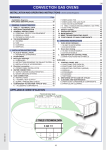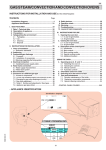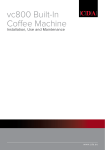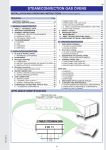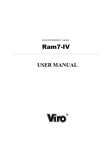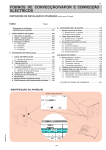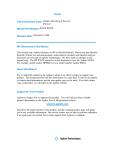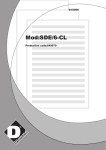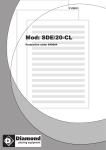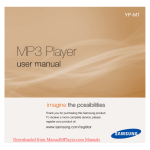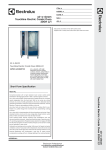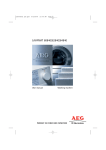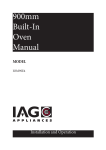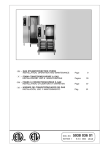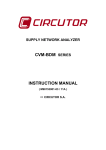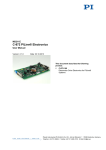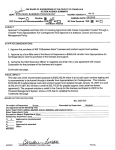Download User Manual - SharePoint
Transcript
GB
ELECTRIC CONVECTION OVENS
INSTALLATION AND OPERATING INSTRUCTIONS
Summary
Page
III. OPERATING INSTRUCTIONS ....................................... 38
- Installation diagrams......................................................... 4
APPLIANCE IDENTIFICATION.......................................... 31
1. APPLIANCE DESCRIPTION ........................................ 32
2. TABLE 1: TECHNICAL DATA....................................... 32
3. GENERAL INSTRUCTIONS ......................................... 33
3.1 PERSONAL PROTECTION EQUIPMENT ............... 33
3.2 RESIDUAL RISKS .................................................... 33
1. OVEN DOOR OPENING ............................................... 38
1.1 6 AND 10-RACK MODEL ......................................... 38
1.2 20-RACK MODEL..................................................... 38
2. Oven door closing ....................................................... 38
2.1 6 AND 10-RACK MODELS ....................................... 38
2.2 20-RACK MODELS .................................................. 38
3. DESCRIPTION OF CONTROL PANEL ......
m 39
3.2 MAIN FUNCTIONS AND SYMBOLS ........................ 39
II. INSTALLATION INSTRUCTIONS .................................... 34
OVEN USE ............................................................................. 42
1. PLACE OF INSTALLATION.......................................... 34
1.1 REFERENCE STANDARDS .................................... 34
3.3 TECNICAL DATA PLATE .......................................... 34
4. THE ENVIRONMENT .................................................... 34
4.1 PACKING .................................................................. 34
4.2 USE .......................................................................... 34
4.3 CLEANING ............................................................... 34
4.4 DISPOSAL................................................................ 34
2. POSITIONING ............................................................... 35
3. Electrical connection .................................................. 35
3.1 POWER CABLE INSTALLATION ............................. 35
4. WATER CONNECTION ................................................. 35
4.1 SUPPLY WATER CHARACTERISTICS ................... 35
4.2 WATER DRAINING SYSTEM................................... 37
5. SAFETY DEVICE ........................................................... 37
6. OPERATION CHECK .................................................... 37
7. MAINTENANCE ............................................................ 37
8. BRIEF TROUBLESHOOTING GUIDE .......................... 37
9. POSITIONING OF MAIN COMPONENTS .................. 37
4. CONTROL PANEL USE ................................................ 42
4.1 SWITCHING THE OVEN ON ................................... 42
4.2 SWITCHING THE OVEN OFF ................................. 42
4.3 SELECTING CONTROLS (AREAS)......................... 42
4.4 MANUAL................................................................... 43
4.5 PROGRAMS............................................................. 48
4.6 CLEANING ............................................................... 48
4.7 SETTINGS................................................................ 49
5. SWITCHING OFF IN CASE OF A FAULT ..................... 51
6. CLEANING AND MAINTENANCE................................ 51
6.2 REPLACING CONSUMABLE COMPONENTS ........ 52
6.3 PARTICULAR CLEANING ........................................ 53
I. GENERAL CHARACTERISTICS...................................... 32
APPLIANCE IDENTIFICATION
"Technical Data" plate
PNC 9PDX
X 260462 05
2. TABLE 1: TECHNICAL DATA
5954 962
00U00
00
5958
6 GN 1/1
260450-260510
260462
260456
260
260451-260511
260463
260457
260
°
**
400
°
**
230
°
**
200
31
GB
I. GENERAL CHARACTERISTICS
1. APPLIANCE DESCRIPTION
surface temperatures.
• Cycle for daily cleaning of oven compartment (CLEANING
SYSTEM) (depending on the model).
• Self-diagnosis for possible malfunctions by means of signalling
with identification codes.
This handbook concerns various appliance models.
For further information regarding your model, refer to Table
1"Technical Data".
For UK and COMMONWEALTH only:
This appliance is designated as a forced draught burner,
therefore the appliance is classed as COMCAT5 and only
installers who held the relevant gas qualification are allowed
to install/commission and service this product.
WARNING:
Failure to use a qualified/authorised installer WILL INVALIDATE THE WARRANTY conditions and may render the
appliance inoperative.
If any doubt please consult the manufacturer for further advice.
Under no circumstances must this product be used unless
installed and /or commissioned by a qualified engineer.
The appliance has the following features:
• Digital indication of temperature.
• Thermostatic probe for measuring the product's "core" temperature (core probe).
• Constant monitoring of cooking parameters during the entire
cycle.
• Compartment rapid fume extraction device for gratinating, with
automatic activation.
• Compartment lamps.
• Door opening double-action safety mechanism to prevent burns.
• Door with double glass: better comfort in the kitchen and low
2. TABLE 1: TECHNICAL DATA
GRIDS
Oven weight (kg)
6GN1/1
10GN1/1
10 GN 2/1
20GN1/1
20 GN 2/1
132
156
202
253,3
344,25
266200
266220
266202
266222
266203
266204
266224
266205
CONVECTOR °
°
°
°
°
°
°
°
°
POWER SUPPLY
VOLTAGE (VOLT)
400
3 N~
230
3~
400
3 N~
230
3~
400
3 N~
400
3 N~
230
3~
400
3 N~
FREQUENCY (Hz)
50/60
50/60
50/60
50/60
50/60
50/60
50/60
50/60
Max. electrical power
input (Kw)
10,1
10,1
17,5
17,5
25
34,5
34,5
50
Mains fuses
(3 x 500V)
25
32
32
50
63
63
125
100
5x2,5
4x4
5x4
4x10
5x10
5x10
4x25
5x16
Fan motor power rating
(Kw)
0,19
0,19
0,19
0,19
0,75
0,38
0,38
1,5
Convection unit power
rating (Kw)
9,6
9,6
17
17
24
34
34
48
Max. food load (kg)
30
30
50
50
100
100
100
200
Pan / tray max. load (kg)
15
15
15
15
30
15
15
30
Power supply cable cross2
section (mm )
Information on sound emissions: The functional components
of the appliances in question have a noise level not exceeding
70 dB (A).
* The oven model is specified at the PNC field on the "Technical
Data" plate located at the bottom on the left side.
32
5954 00U 00
PNC *
GB
3. GENERAL INSTRUCTIONS
3.1 PERSONAL PROTECTION EQUIPMENT
Give below is a summary table of the Personal Protection
Equipment (PPE) to be used during the various stages of the
machine’s service life.
The following symbols are used in the manual to mark and identify
the various types of hazards:
ATTENTION!
DANGER FOR THE HEALTH AND SAFETY OF
OPERATORS.
Protective
garments
Safety
footwear
Gloves
Glasses
Ear
protectors
Mask
Safety
helmet
Stage
ATTENTION!
DANGER OF ELECTRIC DISCHARGE (Electrocution)
- DANGEROUS VOLTAGE.
Transport
Handling
ATTENTION!
RISK OF DAMAGE TO THE MACHINE.
Unpacking
Assembly
Normal use
X
Adjustments
Routine
cleaning
Extraordinary
cleaning
• Before installing and using the appliance, carefully read this handbook as
it provides important information and
instructions on safe installation, use and
maintenance.
Maintenance
Dismantling
Scrapping
Key:
X
X
X
X
X
X
X
X
X
X
X
X
X (*)
X
X
PPE REQUIRED
PPE AVAILABLE OR TO BE USED IF NECESSARY
• Keep this handbook for further consultation by the various operators, or in
case the appliance is resold.
PPE NOT REQUIRED
(*) During Normal use, gloves must be heatproof to protect hands
when removing the hot pan from the appliance.
Failure to use the personal protection equipment by operators,
specialised technicians or users can involve exposure to
chemical risk and possible damage to health.
Attention: Appliance installation, any maintenance
work and conversion to another type of gas must only
be carried out by professionally qualified personnel
authorised by the Manufacturer.
3.2 RESIDUAL RISKS
• This appliance is intended for collective use and is expressly
designed for cooking food. Any other use is deemed improper.
The appliance must only be used by trained staff.
• This appliance is not intended for use by people (including children) with limited physical, sensory or mental abilities or without
experience and knowledge of it, unless they are supervised or
instructed in its use by a person responsible for their safety.
• Switch the appliance off in case of fault or poor operation.
• For any repairs, only consult an After-Sales Centre authorised by the manufacturer and demand original replacement
parts.
Failure to observe the above can compromise appliance
safety and invalidates any form of warranty.
The machine has several risks that were not completely eliminated from a design standpoint or with the installation of adequate
protection devices.
For the Customer’s complete information, the residual risks remaining on the machine are indicated below: such actions are to
be considered incorrect and therefore strictly forbidden.
RESIDUAL
RISK
• Do not clean the appliance with direct
jets of water.
5954 962
00U00
00
5958
• Do not use products containing chlorine (chlorine bleach,
hydrochloric acid, etc.), even if diluted, to clean the steel parts.
• Do not use corrosive substances (e.g. muriatic acid) to clean
the floor under the appliance.
• For further details see the section "Cleaning and maintenance".
for AUSTRALIA
• Warnings:
• Do not store or use gasoline or other flammable vapours,
liquids or items in the vicinity of this or any other appliance.
• Do not spray aerosols in the vicinity of this appliance
while it is in operation.
• Never check for leaks with an open flame
• The appliance is not suitable for a marine environment.
33
DESCRIPTION OF HAZARDOUS
SITUATION
Slipping or
falling
The operator can slip due to water or dirt
on the floor.
Burns
The operator deliberately or unintentionally touches some components
inside the machine or dishes at the outfeed without using gloves or without
allowing them to cool.
Danger of
electric
discharge
(Electrocution)
Contact with live parts during maintenance operations carried out with the
electrical panel powered. The operator
intervenes (with a power tool or without
disconnecting the power to the machine)
lying down on the wet floor.
Falling from
above
The operator intervenes on the machine
using unsuitable systems to access
the upper part (e.g. rung ladders, or
climbs on it).
Tipping of loads
During maintenance on the machine or
the packing containing the machine
with the use of unsuitable accessories or
lifting systems or with load unbalanced.
When handling pans containing food.
GB
Chemical
Contact with chemical substances (e.g.
detergent, rinse aid, scale remover,
etc.) without taking adequate safety precautions. Therefore always refer to
the safety cards and labels on the products used.
polypropylene: roof packing panels, straps
pp
polystyrene foam: corner protectors
PS
4.2 USE
3.3 TECNICAL DATA PLATE
• Our appliances are designed and optimised with laboratory
testing in order to offer high performance and efficiency. In any
case, to reduce energy consumption (electricity, gas and water),
avoid using the appliance empty for long periods or in conditions
that compromise optimum efficiency (e.g. door open). Also, if
possible, preheat the appliance immediately before use.
4.3 CLEANING
• In order to reduce the emission of pollutants into the environment,
clean the appliance (externally and when necessary internally)
with products that are over 90% biodegradable.
Meaning of fields given on the plate:
F. Mod. .................. factory description of product
Comm. Model ....... commercial description
Ser. Nr. ................. serial number
ELX ....................... manufacturer: Electrolux Professional spa
Viale Treviso, 15
33170 Pordenone (Italy)
Made in EU ........... place of manufacture
99-9999 ................ month/year of manufacture
PNC: ..................... production number code
EL: ........................ [C] power supply voltage, [D] phase
Hz ......................... power supply frequency
kW ........................ max. power input
A ........................... current absorption
EL: ........................ [H] electrical prearrangement
CE ........................ CE marking
4.4 DISPOSAL
• At the end of the product's working life, make sure it is not dispersed in the environment.
• Our appliances are manufactured using more than 90% metals
(stainless steel, iron, aluminium, galvanised sheet, copper, etc.)
which can be recycled by means of the conventional recovery
structures, in compliance with the current regulations in the
country of use.
• Make the appliance unusable by removing the power cable
and any compartment or cavity closing devices (when present)
in order to avoid the risk of someone becoming trapped inside.
L
The symbol
on the product indicates that this product
should not be treated as domestic waste, but must be correctly
disposed of in order to prevent possible negative consequences
for the environment and the human health.
Regarding the recycling of this product, please contact the sales
agent or dealer of your product, your after-sales service or the
appropriate waste disposal service.
4. THE ENVIRONMENT
4.1 PACKING
• All the packing materials are environmentally friendly. They can
be stored without risk or burned in a special waste incineration
plant. Recyclable plastic components are marked as follows:
PE
polyethylene: outer wrapping, instructions bag, gas
nozzle bag.
II. INSTALLATION INSTRUCTIONS
1.1 REFERENCE STANDARDS
Attention: The external panels of the oven must be
removed for the operations described in this section.
As the unit must be operating in order to carry out some
adjustments, pay maximum attention to the live parts.
for AUSTRALIA
• This appliance shall be installed only by authorised persons
and in accordance with the manufacturer’s installation
instructions, local gas fitting regulations,municipal building
codes, electrical wiring regulations, local water supply
regulations, AS5601-gas installation, health authorites and any
other statutory regulations.
Attention: Maintenance in the upper part of the
appliance requires the use of ladders with protection (guard).
1. PLACE OF INSTALLATION
• Only install the appliance in a suitably ventilated place.
34
5954 00U 00
• Install the appliance in compliance with the current local and
national regulations.
GB
• Appliance max. leakage current is 5 mA.
• The appliance must be connected to an efficient earthing system.
For that purpose, the connection terminal block
has a terminal with the symbol
for connecting the earth wire.
The appliance must also be included in an equipotential system.
This connection is made with the setscrew marked E , located
externally near the power cable entry.
The equipotential wire must have a section of at least 10 mm2.
2. POSITIONING
• Unpack the appliance, carefully remove the protective film from
outside panels, making sure no traces of glue remain. If necessary,
remove them using a suitable solvent.
Remove the packing using protective gloves.
Lift the appliance with a lift truck, remove the base, and position
it the place of use.
Remove the protective film and make sure the packing material
is not dispersed in the environment but disposed of according to
the current regulations in the country where the product is used.
3.1 POWER CABLE INSTALLATION
To connect the power cable to the appliance, proceed as follows:
Model 6 - 10 - 20 GN
• Remove the left side panel.
• Connect the cable to the terminal block as shown in the wiring
diagram attached to the appliance, and secure it with the special
cable gland.
The manufacturer declines any liability if the current national
and local regulations and possible safety regulations are
not respected.
20 GN
6-10 GN
20 GN
6-10 GN
4 23 ” 120 mm
32
5 1 ” 130 mm
8
11 7 ” 300 mm
64
6-10 GN
20 GN
4. WATER CONNECTION
(See the installation diagrams at the beginning of this handbook)
When connecting the appliance to the water system with
hoses they must be new and not used.
The oven has two separate water supply inlets ("B" and "N").
• For disposal of the packing, see the section "The Environment"
• For the overall space required and connection dimensions,
refer to the installation diagrams given on the first pages of this
instruction handbook.
• The left side of the appliance must remain at least 50 cm from
other surfaces to enable maintenance operations, whereas the
right side and back must remain 10 cm from any surface.
• Position the appliance on a flat surface and, if necessary, adjust
the height of the worktop by means of the adjustable feet.
• The appliance is not suitable for built-in installation.
I
Attention:
Make sure the steam coming from the oven discharge or adjacent appliances does not reach
the aeration vents (for cooling internal components), located at the bottom of the appliance.
B
C
C - Water drain manifold
B - Injection water supply connection
N - Condensate and Cleaning water connection
I - Power cable entry
The feed pipes of both inlets must be provided with a mechanical
filter and shutoff valve. Before installing the filters it is advisable
to allow a certain amount of water to run in order to clear the pipe
of any solid particles.
3. ELECTRICAL CONNECTION
5954 962
00U00
00
5958
N
• Connection to the electrical power supply must be done in
compliance with the current national and local regulations.
• Before connecting, make sure the voltage and frequency match
that given on the dataplate.
• The appliance must be connected to the power supply in a
permanent way. Connection must be made with an H05 RN-F
type cable. The power cable must be installed in a metal or rigid
plastic pipe without any sharp parts.
• An omnipolar switch of suitable capacity with contact opening
distance of at least 3 mm must be installed ahead of the appliance.
This switch must be installed in the building's permanent electrical
system, in the immediate vicinity of the appliance.
• A device (interlocked plug, lockable switch or similar devices)
lockable in the open position during maintenance must be installed
ahead of the appliance.
4.1 SUPPLY WATER CHARACTERISTICS
The appliance must be supplied with drinking water having the
specific characteristics given in this section.
To appraise the suitability of the supply water the following
characteristics must be measured:
- Total Hardness
- Conductivity
- Chloride Cl- pH
35
GB
WATER CHARACTERISTICS INLET "B"
WATER CHARACTERISTICS INLET "N"
To guarantee correct appliance operation, several water
treatment systems may have to be installed. For that purpose,
see the instructions of the following Flow Chart :
To guarantee correct appliance operation, several water
treatment systems may have to be installed. For that purpose,
see the instructions of the following Flow Chart :
Water inlet “B”
5° f
Water inlet “N”
=
50 ppm Ca CO3
5° f
2.81° d
2.81° d
3.51° l
Chloride
appraisal
3.51° l
Hardness
appraisal
1.00 moz / cuB CaCO3
0.50 mmol / l
< 10 ppm
=
50 ppm Ca CO3
1.00 moz / cuB CaCO3
0.50 mmol / l
> 10 ppm
< 5° f
> 5° f
See instructions of
graph page 367
459
A water softener must be
installed *
WITH FILTER
(ORSMOTIZER or NANOFILTER)
NO ACTION REQUIRED
Water system ready
to be connected to
oven
Hardness
appraisal
< 5° f
Make sure the dynamic
pressure is between
150 and 450 kPa
(1.5-4.5 bar / 22-65 psi)
> 5° f
A water softener must be
installed *
* If deemed suitable by the installer, the water softener can be
replaced with a NANOFILTER, provided the minimum water flow
rate for the oven wash cycle is respected.
Water system ready
to be connected to
oven
Note: The softener (Automatic Water Softener) with automatic
regeneration has a kit (Resin Sterilizer) for sterilization of the
resins (additional request).
Make sure the dynamic
pressure is between
150 and 450 kPa
(1.5-4.5 bar / 22-65 psi)
CHECK SUPPLY PRESSURE INPUT "B" AND "N"
The pressure measured upstream of the oven (and downstream of
any WATER FILTRATION SYSTEMS installed) must be between
150 and 450 kPa (1.5 - 4.5 bar / 22-65 psi) measured in dynamic
conditions, i.e. during the washing phase.
* If deemed suitable by the installer, the water softener can be
replaced with a NANOFILTER.
B
ATTENTION:
- The periodical check of filter functionality, according to that
indicated by the manufacturer, is important to avoid compromising
appliance operation and to prevent the risk of corrosion.
- For good operation of the water softeners and filters make sure
to regularly service them.
N
150-400 kPa
(1,5-4,5 bar / 22-65 psi)
H 2O
Note: The softener (Automatic Water Softener) with automatic
regeneration has a kit (Resin Sterilizer) for sterilization of the
resins (additional request).
H 2O
- To prevent damaging the appliance, at every periodical
regeneration do a filter wash cycle without introducing water in
the oven.
- The manufacturer declines any liability in case of incorrect
maintenance.
WATER
FILTRATION
SYSTEM
150-400 kPa
(1,5-4,5 bar / 22-65 psi)
WATER
FILTRATION
SYSTEM
Attention (water inlet N)
If the feed pipes supplied with the appliance are not long
enough for installation, use longer ones with internal
diameter of at least ø 20 mm and without union elbows.
5954 00U 00
Attention:
Dispensers of substances for preventing scale in
the pipes (e.g. polyphosphate dispensers) must
not be used because they can compromise correct
appliance operation.
36
GB
6. OPERATION CHECK
For UK and COMMONWEALTH only:
This appliance is designated as a forced draught burner, thereIn
accordance with "the water supply (Water Fittings) Regulations
1999", it is mandatory that this appliance when installed to the
mains water supply has fitted an approved "double check valve"
connected upstream of the appliance.
Failure to comply with these regulations may lead to the
appliance being disconnected.
- Switch the appliance on, as described in the section "Operating
instructions";
- Explain appliance operation, routine maintenance and cleaning
operations to the user, with the help of the instruction handbook.
Attention:
- During operation, pay
attention to the hot areas of the exterior surface.
- Do not place objects on the outlets located at the
top of the appliance.
4.2 WATER DRAINING SYSTEM
- With oven hot, check the correct working of the door closing
mechanism. If necessary, adjust closing by adjusting the position
of the catch.
Connect drain fitting “C” to a drain pipe of the same diameter
which is between 0.5 and 3 metres in length and is resistant to
temperatures of at least 100°C. The drain pipe must be siphoned
(height 80 mm) to an open drain “O” (“Air-Break”) or floor grating
(see Fig. 12b) in order to prevent any back-flow from the sewage
system from reaching the piping inside the oven or oven chamber.
Check the hoses and elbows on metal pipes for kinks or pinching
along the entire drain line and make sure the drain line has a
minimum gradient of 5° to prevent water from collecting inside the
system.
7. MAINTENANCE
The components requiring routine maintenance are accessible
by opening the control panel, and left and rear panels.
8. BRIEF TROUBLESHOOTING GUIDE
Important: The drain system must be installed so
that any vapours from the open drain do not enter
the aeration vents under the appliance.
max 3m
min 0,5m
Oven chamber heating not started or inefficient. Possible
causes:
- Oven chamber temperature limit switch tripped
- Damaged heating elements
- Damaged heating element contactor coil
- Damaged thermostat probe showing error “EPt1”.
- Damaged controller
- Fuse “F2” blown, see circuit diagram.
AIR-BREAK
min 1m
min 0,02 m
Even with correct use of the appliance, malfunctions can occur.
OK
C
Oven chamber temperature reading incorrect
Possible causes:
- Damaged electronic controller
- Thermostat probe damaged, dirty or interrupted, see error “EPt1”.
min 5°
T max = 100°C
0,08 m
O
Oven switches off
Possible cause:
- Fuse “F2” has blown due to damage of control circuit components.
AIR-BREAK
KO
Oven chamber lamp fault
WARNING: Switch off the appliance before changing oven
chamber lamps.
C
9. POSITIONING OF MAIN COMPONENTS
O
(Any operation inside the appliance must only be carried out
by an installer authorised by the Manufacturer).
Removing the control panel provides access to the following
components:
- Electronic circuit boards
- Oven chamber temperature limit thermostat
- Fuses
- Door microswitch
- Oven chamber lamp transformer
- Geared motor for the oven chamber pressure relief butterfly valve.
5. SAFETY DEVICE
The appliance is equipped with the following safety devices:
- Fuses, see the wiring diagram, located behind the control panel.
For replacement, unscrew the cap and replace the damaged
component with another one having the same rating; this value
is given on the label located in the same place.
To gain access to all other components remove the appliance’s
left and rear side panels.
- Compartment manual-reset safety thermostat located behind
the control panel; it shuts off the supply to the convector.
5954 962
00U00
00
5958
Resetting operations must be carried out by specialised technical
personnel after eliminating the causes of interruption.
- Automatic-reset thermal device inside the fan, which is activated if the fan overheats, protecting unit operation; it cuts off the
electrical power to the appliance.
37
GB
III. OPERATING INSTRUCTIONS
Before starting the appliance, carefully read this handbook. The
instructions and information given in it are important for correct
and optimum oven use. If required, further details regarding its
characteristics and cooking performance can be obtained from
the dealer.
• To avoid obstructing the fume and steam discharge pipes, do
not place pans or utensils of any kind on the oven.
• Do not place objects (e.g. pans) under the bottom of the oven,
so as not to obstruct any cooling air inlet or outlet holes.
• Have the appliance fully checked periodically (at least once a
year). For that purpose, it is advisable to stipulate a maintenance
contract.
• The core probe is a precision component. Absolutely avoid
impacts, forcing when inserting, and pulling of the flexible cable
(in particular when using the trolley-mounted structures). The
warranty does not cover the replacement of core probes
damaged by improper use.
• When arranging food inside the oven compartment, keep a
space of at least 40mm between trays, to ensure better circulation of hot air.
• If the oven is installed near appliances that produce greasy
fumes (e.g. fryer), make sure to use the air filter (not supplied),
to be placed under the control panel, to protect the internal
electronic components.
• During preheating of oven 20 GN 1/1 or 2/1, insert the trolley
(without food) or the special accessory (not supplied) to close
the bottom opening between the compartment and door. This
prevents steam from coming out and into the control panel with
consequent damage to the electronic board.
MODELS WITH DOUBLE OPENING SYSTEM (on request)
The oven has a double opening system to prevent being exposed
to steam when opening the door completely; therefore carry out
the following operations:
a) Turn the door handle all the way clockwise.
The door opens a little, hooking on the stop.
The cooking cycle is stopped, if in progress.
1
b) Turn the handle all the way anticlockwise to open the oven
door completely.
• Do not salt food inside the oven, in particular with humid
cycles.
• Do not place flammable liquids (e.g. spirits) inside the oven
during operation.
The maximum height at which the trays are placed
in the oven must not exceed 1.6 m. This applies if
installed according to the instructions and using
original accessories (except for stacked ovens).
In case of stacked ovens or in any other case when the above
distance is exceeded, the following sticker (supplied) must be
placed on the front of the oven in a visible position at a height
of 1.6 m from the floor.
ATTENTION: To avoid burns, do not use recipients
containing liquids (or products that become liquid with cooking) on levels that are not easily
visible. This is to prevent spilling during handling.
2
1.2 20-RACK MODEL
Attention! Risk of burns.
Always open the door with caution when the oven
is hot.
a) Turn the handle anticlockwise 90° to open the door completely.
The cooking program is stopped, if in progress.
1. OVEN DOOR OPENING
1.1 6 AND 10-RACK MODEL
Attention! Risk of burns.
Always open the door with caution when the oven
is hot.
a) Turn the door handle all the way in either direction (indifferently)
to fully open the oven door.
The cooking cycle is stopped, if in progress.
1
2. OVEN DOOR CLOSING
2.1 6 AND 10-RACK MODELS
Closing is obtained by pressing the door against the oven enough
to lock it.
1
38
5954 00U 00
2.2 20-RACK MODELS
a) Turn the door handle all the way anticlockwise and bring the
door against the oven.
b) Keeping the door pressed against the oven, bring the handle
to the upright position and lock it.
GB
3.
M
DESCRIPTION OF CONTROL PANEL ......
Hot air cycle with compartment vent closed:
for cooking with high humidity. (Default setting)
The control panel has the following controls:
ON/OFF oven switch.
_______________
Digital thermostat for
control of compartment
temperature.
Timer for control of
cooking time.
The letter S next to the
number means short cooking cycle; see symbol
MM:SS.
____________
Touch screen
with direct selection of functions
by simply touching the
required symbol (icon), to activatethe corresponding ovenfunctions.
or
Digital thermometer/
thermostat for control
of product core temperature.
Cooking with ECO-DELTA: for cooking large pieces
of food (at least 5kg, e.g. whole turkey, leg of pork, etc.).
In this cooking mode a temperature setting of between
1°C and 120°C is selected.
In this case, cooking is moderate and long, since
the COMPARTMENT temperature is automatically
adjusted according to the temperature inside the food
(CORE PROBE), maintaining a constant difference
(ECO-DELTA) between them, from start to end of
cooking.
The ECO-DELTA function is only possible with the
core probe inserted.
USB port
________________
Data input and output
3.2 MAIN FUNCTIONS AND SYMBOLS
Example:
COOKING:
ECO-DELTA
=
CORE PROBE =
COMPARTMENT =
MANUAL
START
80°... 80...80...
10°... 11...12...
90°... 91...92...
......
80...
40...
120...
END
80°C (set)
60°C (set)
140°C (result)
Fast compartment cooling: useful for going from
one type of cooking to another at lower temperature;
it enables fan rotation and automatic injection of
water (TS < 180°C) even with the door open.
Hot air cycle: for roasting and gratinating with max. temperature
300°C.
Attention! Risk of burns.
Always open the door with caution when
the oven is hot.
Humidity setting and adjustment: for
activating or excluding the humidity or
adjusting the required level in the Hot
Air Cycle.
Continuous cooking: the cooking time is endless,
therefore it is necessary to press STOP when the
food is cooked.
5954 962
00U00
00
5958
Hot air cycle with compartment vent open:
for very dry cooking, allowing the removal of
humidity when necessary (max. temperature
300°C).
MM:MINUTES and SS:SECONDS for short cooking
cycles. Converts minutes into seconds and the letter S
appears next to the number in the bar as an indicator
Hot air cycle with adjustable humidification
automatic: for cooking with humidification
adjustable from 1 to 10.
39
GB
INFORMATION - NOTES - WARNINGS
MULTIPHASE
Cooking with phases in sequence: for setting
cooking programs with several phases in automatic
sequence (max. 15 phases).
Information area
Area displaying current
Status, Error, Warning
and Utility information.
Active pause phase
Warning light signalling oven door open.
Add pause phase: by entering a time value in this
mode it is possible to delay the start of cooking programs or include a pause between two cycles (e.g.
proving).
burner off
Active Maintaining Cycle phase.
Error
Add Maintaining Cycle (70°C): for slow and prolonged
cooking, typically for meat (large cuts). Activated at the
end of cooking.
Combinable with all cycles.
Attention
Information
Queries
VARIOUS AND COMMON FUNCTIONS
UTILITIES
Low speed cycle (fan): for gentle baking,
such as light patisserie. Combinable with all
cycles.
Compartment preheating: indicates that the oven is
preheating the compartment (please wait).
This phase can be skipped in MANUAL mode but not
in AUTOMATIC mode.
Pulsed speed cycle (fan): for low temperature cooking, ideal for maintaining cooked
products, dehydrating or drying for vegetables
or finishing food. Combinable with all cycles.
SKIP PHASE: the next foreseen phase can be skipped
for particular types of cooking.
- Compartment preheating (excluding AUTOMATIC)
- Low temperature phases (PREHEAT, SEARING)
Skip PHASES in Multiphase: one or more phases
can be skipped during cooking with Multiphase.
Normal speed cycle (fan): for normal cooking.
Ideal for roasting, gratinating and classic
cooking. Combinable with all cycles. (Default
setting)
Manual injection of water in compartment:
for instantly increasing the humidity level
during a cooking cycle. Use the + and - buttons
to adjust the injection duration in seconds (10
s intervals).
Confirm
Go back to previous page
Cancel space (Backspace)
Save Program
Multitimer: for setting cooking of foods at the same
temperature but at different times (max. 14).
Custom
40
5954 00U 00
Find Program
Programmed Start: allows the cooking cycle to be
started later by setting the required time.
GB
Upload data in oven from USB port
Download data from oven on USB port
Restore oven configuration to default values (Reset)
Identity Card: Oven identification giving rating data
and software version. This item is located in the Settings drawer.
Drawer
The drawer is an expansion located inside several environments of
the menu and contains options that are useful in some functions.
5954 962
00U00
00
5958
Technical assistance
41
GB
OVEN USE
4. CONTROL PANEL USE
4.2 SWITCHING THE OVEN OFF
To switch the oven off, press the button O (O - I) of the following
switch:
Foreword:
When selecting certain functions, the initial status is restored if
no button is pressed within 15 seconds (approx.).
O°I
4.1 SWITCHING THE OVEN ON
Before using the oven, make sure:
- the external electric safety switch is on;
- the water shutoff cocks are open;
- the oven outlets are not blocked.
4.3 SELECTING CONTROLS (AREAS)
The controls are mainly divided into 5 different management areas
for the various functions. These are selected from the CONTROLS
MENU in the drop-down menu of the first line of MANUAL mode.
Switch the oven on by pressing the button I (O - I) of the following
switch:
Manual
Programs
O°I
Cleaning
Settings
= manual cooking mode (conventional).
= use of existing programs (or recipes) and
storing of new ones.
= cleaning programs for oven compartment.
= variation and configuration of functions.
the start screen will appear, during which the electronic board
performs several checks.
Touch screen
Touch the symbols on the "touch screen" to select the oven
functions, setting and modifying the relevant values. It is also
arranged with a basic functions menu to simplify use, and can be
customised as required by adding or removing some functions.
The "touch screen" has a similar use to that of a cell phone and
computer, with drop-down menu and keypad for entering values.
In some cases, by touching the required symbol a screen relevant
to the symbol appears, and in others only the function is selected.
TOUCH the required part of the Display to perform any
operation, such as:
- select
- confirm
5954 00U 00
- change screen (or Display page)
42
GB
In this way a cooking cycle has been set; now, just close the door
and touch START to start the Cycle.
The PREHEATING stage starts, after which the message "LOAD"
appears, indicating to place food in the oven; close the door to
start cooking.
In case of AUTOMATIC START, just close the door to automatically start the cycle.
4.4 MANUAL
After SWITCHING THE OVEN ON the following MANUAL cooking
mode screen appears:
After about 10 seconds the following Cooking in Progress screen
will appear:
Drop-down "CONTROLS MENU":
Manual
Programs
Cleaning
Settings
Cooking PHASE (2 of 3)
Phase 2/3
Hot Air cycle * in progress
Convection
HUMIDIFICATION in progress
3
160°
2:17
Manual
Cooking PHASES (1 of 1)
Phase
1 of 1
Cooking CYCLES
Set HUMIDIFICATION
3
0:30
48°
0:30
2:30
Set
TEMPERATURE
TIME in progress
set TIME
HALF SPEED in progress
(example)
Current TIME
Set TIME
START
* In PROGRAMMED mode, the word "Convection" will be replaced
by the name of the Program or Recipe in progress (e.g. Chicken)
This figure (for information) shows nearly all the possible cases;
but only those concerned are presented.
Touch this screen to return to the MANUAL control Settings.
Any setting already made can be modified and the Cooking Cycle
can be stopped by touching STOP for a few seconds.
The SKIP COMPARTMENT PREHEATING function also appears
with the respective symbol
next to the STOP button, to skip
preheating for particular types of cooking.
Start CYCLE
INFORMATION
AREA
"DRAWER" drop-down menu
with Utilities in several items of the CONTROLS MENU
STOP
To set a cooking cycle, select the required CYCLE:
HOT AIR
The previous description regarded setting a cooking Cycle. Now,
this will enable setting others in a more complex way, by adding
the other functions made available.
(touch)
and set:
- HUMIDIFICATION
(touch CYCLE button)
- TEMPERATURE
(touch the bar
)
- TIME
(touch the bar
)
(touch the bar
and then
)
5954 962
00U00
00
5958
or CORE PROBE
Set TEMPERATURE
43
GB
The functions in MANUAL Cooking mode are as follows:
cycle HOT AIR
HUMIDIFICATION TEMPERATURE
TIME
COREPROBE
---->
adjustable
compartment vent open
compartment vent closed
Eco Delta *
x(
x
x
-
x (max. 8 hours)
-
x (from 10° to 99°)
-
---->
---->
endless
MM:SS (short cooking cycles) -
---->
---->
)
x
x (from 20° to 120°)
-
x
max. 59 min. and 59 sec.
-
Eco Delta: on setting the temperature range, a small
*
triangle will appear as a reference next to the value; also, the
time bar goes to that of the core probe
for the relevant setting.
E.g. In the HOT AIR cycle, as indicated in the previous table, it
is possible to set the Humidification, Temperature, Time or Core
Probe, and Temperature with Eco Delta, compartment Cooling,
endless Time for continuous Cooking (conventional cooking) and
Short Cooking Cycles (MM:SS).
To add more functions, there are the UTILITIES situated in the
DRAWER and selected as cooking cycle variables.
To set the data of the various functions, a keypad like the following
is used:
To zero-set the value just entered, touch the
0 on the keypad.
If a function (e.g. Eco Delta
) has been
set on the keypad, to cancel it just touch the
same button again.
To return to the initial setting, select another
cycle and return to the same.
DRAWER open
UTILITIES
Cooling: it is possible to set an oven
compartment cooling temperature to be
reached, which will be indicated with the
corresponding symbol on the cooking in
progress screen.
Compartment cooling therefore occurs
manually and is done outside the cooking
cycle.
5954 00U 00
INFORMATION
real data
44
GB
The figure shows phase 1 with the following settings:
UTILITIES (see page 40)
HOT AIR
1
Fan speed *
x
Injection of water in compartment
x (from 10sec. to 120sec.)
5
160°
0:30
Programmed Start
x
Store programs
x
cycle
Also, one or more phases can be skipped during cooking; press
next to phase 3 (ex. in figure) to go to this.
the symbol
3
*
The default speed is the maximum and never appears in
the information field, whereas the others will appear if selected
(half or pulsed).
compartment temperature
28°
core probe temperature (C°)
01:58
clock (1 hour : 58 minutes)
50%
225° 0:45
The Multiphase also has special phases, such as:
- Pause
for setting a pause between cooking cycles.
- Maintaining cycle
with the possibility of setting a food temperature that is kept constant for an infinite time 8
INFORMATION (real data)
175°
phase number
Hot Air cycle
humidification
temperature (C°)
cooking phase time (0 hours : 30 minutes)
(C°)
4.4.2 MULTITIMER
With the MultiTimer system it is possible to set a different time for
each recipe (chicken, potatoes, etc.) or for each pan placed on
the various levels, e.g. starting from level 1 at the top and going
down to 2, 3, etc.
This function also allows the oven to be used with an "à la carte"
menu, where the food can be placed in the oven at the required time.
To set the MultiTimer, proceed as follows:
1) open the drawer in Manual mode and press the relevant button
MultiTimer button
Then press the following buttons:
4.4.1 MULTIPHASE
Food can be cooked with different modes during its cycle and
therefore in different phases.
The oven enables programs consisting of several sequential phases (up to a max. of 15 phases). During cooking, going from one
phase to the next occurs automatically, until automatic stopping
of the program with completion of the last set phase.
A cycle with several phases is set by carrying out the following
operations:
1) switch the oven on;
2) Set for PHASE 1:
- cooking mode (humidification if necessary);
- compartment temperature;
- cooking time (or alternatively the core probe temperature).
3) Press the "Phase" button and then the "Add new phase" button.
4) For PHASE 2 and following, set as per PHASE 1.
When there are several phases, these will be listed, giving the
relevant settings (an arrow will scroll the next ones which are
not displayed).
2) START
cycle start for setting the Multitimer
START
3) MultiTimer
to access the setting of times.
Manual
Multitimer
Timer 1:
Timer 3:
MultiTimer -------->
Timer 5:
Timer 7:
Timer 9:
Timer 11:
Timer 13:
-- : --- : --
-- : --
-- : --- : --
-- : --
-- : --
Timer 2:
Timer 4:
Timer 6:
Timer 8:
Timer 10:
Timer 12:
Timer 14:
-- : --- : --
-- : --
-- : --- : --
-- : --
-- : --
Manual
Phase
1
5
11of
of12
1
160° 0:30
3
120° 1:15
50%
225° 0:45
4
0:15
2
160°
48°
0:30
5954 962
00U00
00
5958
Add New Phase
0:30
Add Pause
4) Timer1
Skip phase basket
5) --:--
Utilities (in drawer)
and enter the recipe name (chicken, potatoes,
etc).
and enter the time with the keypad.
For Timer2 and following, set as per Timer1.
Pause phase
To start the cooking cycle, open the oven door, load the food and
close the door.
The MultiTimer will start the countdown with the position having
the shortest time setting.
Scroll list arrow
Add phase button
At the end of each set cooking time the oven will sound a beep
to indicate the type of food cooked. Open the door and remove
the ready to serve product.
Auxiliary functions
Save Program
45
GB
4.4.3 ECODELTA
The ECO DELTA function enables cooking without harming the food with high temperatures; this ensures more gentle
and more even cooking, with less weight loss.
This is an advanced cooking method, where the oven compartment
temperature varies according to the core temperature
of the food.
The operator can select a Delta value of between 20°C and
120°C; it is advisable to set a value between 20°C and 70°C, and
a value between 10°C and 99°C for the Core Probe. The oven
compartment temperature is automatically adjusted in order to
always be higher than that in the core of the product.
TEMPERATURE
tpar
com t
n
me
C°
120
e
cor
be
pro
70
Δ T (Eco Delta) = 50°C
20
0
TIME
The graph shows an example with a set Delta of 50°C where the
compartment temperature increases, keeping this difference of
50°C constant with respect to the core probe.
This type of cooking is slower than the conventional cooking
method but has the advantage of obtaining better product results
and quality.
This type of cooking is ideal for large pieces of meat.
4.4.4 INFORMATION AREA
0:30
0:30
X
The information area is the zone above the drawer that displays
oven operation status with icons, subdivided into items.
The figure above gives (starting from the left) the following:
door open
error x
5954 00U 00
fan speed,
46
GB
4.3.6 CORE PROBE USE
4.3.7 END OF COOKING
(PRODUCT CORE TEMPERATURE CONTROL)
The core probe allows accurate control of the core temperature
of the product being cooked. This enables setting of the required
value (from 10°C to 99°C) and automatic stopping of cooking
when that value is reached.
Attention: The core probe is a precision component.
Absolutely avoid impacts, forcing when inserting, and
pulling of the flexible cable (in particular when using
the trolley-mounted structures). The warranty does
not cover the replacement of core probes damaged by improper use.
At the end of the set time, the cooking cycle automatically stops
and the oven buzzer sounds continuously.
The display shows the message:
COOKING FINISHED !
Several parameters such as the following are also displayed:
- total time
Open the door and remove the product.
Attention! Risk of burns.
Always open the door with caution when the oven
is hot.
After selecting the time icon select that of the core probe and
press START to start the cycle.
- Wait until the compartment temperature field indicates reaching
of preheating (the message LOAD appears).
- Open the door and introduce the product to be cooked.
Attention! Risk of burns.
Always open the door with caution when the oven
is hot.
Notes:
- The buzzer can be stopped in advance by carrying out any
operation on the control panel or by opening the door.
The cooking cycled can be manually stopped by keeping
the STOP button pressed for a few seconds.
A cycle identical to that just completed can be repeated by
pressing the START button again.
The maintaining (HOLD) cycle can be done.
1) Remove the core probe "A" from its seat "B" and insert it in
the product without forcing excessively, making sure the tip (the
sensitive part) is positioned near the centre of the product.
A
B
1-sensor core probe
- Close the door and press the START button.
2) Stopping the cycle. When the required product core temperature is reached the oven stops automatically and the elapsed
cooking cycle time is displayed.
3) Core probe mode deactivation. Set a cooking time on the
Timer
. This action automatically cuts out the core probe,
whereas it is the opposite when the time is set.
The core probe mode is also deactivated when the oven is
switched off.
5954 962
00U00
00
5958
Note:
With vacuum packed food products it is necessary to use the
special external core probe (accessory available on request), to
be connected to the USB socket. For its use, see the instructions
included with the accessory.
47
GB
4.5 PROGRAMS
4.5.5
LOAD / SAVE PROGRAMS
LOAD recipes / programs in Oven from USB:
The PROGRAMS control is used for already stored programs
(or recipes), storing new ones and managing them inside a list.
1) Insert the USB key.
2) Access the Programs menu
3) Open the drawer and select the symbol
program search
(upload from USB)
Programs
4) Select the required file (e.g. UI40_01.prg)
Search...
Wait for completion of the loading process.
Attention: Recipes / programs with the same name will be
overwritten.
Apple Crumble
Apple Strudel
BBQ Chicken
SAVE recipes / programs from Oven on USB:
Boiled Eggs
Chicken Breast
1) Insert the USB key.
2) Access the Programs menu
3) Open the drawer and select the symbol
Chicken Legs
Croissants
5) Press OK and remove the key.
(save on USB)
Wait for completion of the save procedure.
4) Press OK and remove the key.
list of programs (example)
program cancel button (basket)
4.6 CLEANING
4.5.2 PROGRAM SEARCH
CLEANING SYSTEM
This cleaning system carries out automatic compartment washing
with suitable detergents according to the amount of grime detected;
therefore the following 4 cycles have been provided for:
To find a program, enter the name using the keypad and press
OK. The program with name closest to the one required will be
highlighted on the list.
Program Search Name
CLEAN Soft
For still fresh grime from not very greasy cooking
|
CLEAN Medium
For normal grime from greasy cooking.
ABC
abc
123!?
./=
àèé
A
a
B
b
C
c
D
d
eE
Ff
G
g
H
h
iI
Jj
K
k
Ll
CLEAN Strong
For heavy grime from very greasy cooking (e.g. roast
chicken, sausages).
CLEAN Extra Strong
For heavy grime from very greasy cooking (e.g. roast chicken, sausages) even with dried residuals (encrustations).
= Upper case letters
= Lower case letters
= Numbers
= Symbols
= Other characters
To use these stored programs, proceed as follows:
4.5.3 START PROGRAM
Press the button of the Program Name on the Program List to
access the Start screen and set the cooking parameters or start
the program.
Note 1:
Before cleaning the compartment with the CLEANING SYSTEM,
remove the grease filter (if present).
The CLEANING SYSTEM cycle starts when the temperature has
automatically reached 70°C in the compartment.
Before carrying out a CLEANING SYSTEM cycle, make sure there
is detergent in the containers (located under the control panel on
models 6-10GN1/1 or independent in models 20GN1/1-2/1) and
that it is of the required type, therefore see par. 6. CLEANING
AND MAINTENANCE.
4.5.4 SAVE PROGRAM
Press this button to access the screen to save
the program (or recipe); this is similar to the search by
entering a name and confirming with OK.
48
5954 00U 00
ABC
abc
123
./=
àèé
X
GB
Warning:
In case of complete emptying of the detergent and/or rinse aid
containers or emptying of their supply tubes, the CLEANING
SYSTEM cycle must be started after firstly doing the CLEAN 1
cycle, then the same or other cycles. This operation allows the
pipes to be refilled with the appropriate liquids and the cleaning
cycles to be done correctly.
If the CLEANING SYSTEM is not used for long periods, it is
necessary to do a cleaning cycle (CLEAN 1) with water instead
of detergent and rinse aid before and afterwards, to flush the
respective supply pumps.
4.7 SETTINGS
Select one of the
following items:
g
Language
International
Date
Clock
Food safety
.........................
.................................
Proofing
International
Date
Clock
Food Safety
• Select a cleaning cycle (Medium is preset).
Green Spirit /
Economizer
LANGUAGE
Settings
Cleaning
or
and
Language
Green Spirit
ਛᢥ
Soft
0:45
0:35
0:25
ᣣᧄ⺆
Medium
1:00
0:45
0:35
Ȼɴɥɝɚɪɫɤɢ
Dansk
Strong
1:30
1:15
1:05
Extra Strong
2:30
2:10
2:00
Deutsch
Eesti
English
Cycle duration
2 hours
30 minutes
select the language
• If necessary, select one of the Green Spirit functions.
scroll list of languages
Green Spirit
INTERNATIONAL
set the language
Skip Rinse Aid
Soft
Skip Drying Phase
0:25
Settings
Reduce Water Consumption
Medium
1
0:55
2
International
Language
The "Green Spirit" function
enables use of the cleaning programs in respect
for the environment.
English
Date Format
If "Skip Rinse Aid" is selected, remember that the traces of
scaling could remain in the compartment after cleaning.
-
For "Skip Drying Phase" it is necessary to open the door
after cleaning, to air the oven.
DD/MM/YYYY +
29/03/2010
Time Format
For "Reduce Water Consumption" make sure an efficient
ventilation system is installed.
Reduction occurs by deactivation of fume suppression.
24 H
AM/PM
Temperature
• Press START to start the cycle.
If necessary, to stop the cleaning cycle press STOP for a few
seconds.
°C
Back
°F
Next
5954 962
00U00
00
5958
select the unit of measure for temperature
(°C Celsius or Fahrenheit °F)
select the required time format
select the required date format (+/-)
49
GB
DATE
MANUAL
TIME
Enable Manual
General
Show real and set value
Multi-phase cooking
Delayed start
Timer/Temperature dialogs
Short cooking
MultiTimer cooking
Eco-delta cooking
Hold
Default convection temp. 70°
Default steam temp. 70°
Probe temp. increase: Δ5°
Default cycle
>
Enter the date and time with the +/- sign (or with the keypad).
Settings
Settings
Date
Time
Day
30
4:35
Month
07
PM
1
2
3
4
5
6
7
8
9
0
AM/PM
Year
2009
PROGRAMS
Enable Programs
Abilita salvataggio Programmi
Enable Programs save
The example settings in the 2 figures are:
Date
30 July 2009
CLEANING
Time
4:35 p.m. (PM: Post Meridiem)
Enable Cleaning
Force after 0:00 of cooking
Default cycle
Soft
Medium
Strong
Extra strong
PASSWORD
Set password
FOOD SAFETY
AUTOSTART
Enable Autostart
Settings
Food Safety
Food Safety
HACCP
OFF
Basic
Integrated
HACCP (Hazard Analisys and
Critical Control Points)
Basic selected
save Basic HACCP data on USB
LOAD / SAVE CONFIGURATION
SAVE Oven Configuration on USB:
Save HACCP Log to USB
1) Insert the USB key.
2) Access the Settings menu
3) Open the drawer and select the symbol
START
- HACCP: according to the system required, cooking data can be
recorded on USB key (Basic) or on Personal Computer (Integrated)
(download on USB)
Wait for completion of the download process.
4) Press OK and remove the key.
LOAD Oven Configuration from USB:
GREEN SPIRIT
1) Insert the USB key.
2) Access the Settings menu
3) Open the drawer and select the symbol
General
Oven standby after: 0:30
Turn off lamps
After 0.15 when not cooking
Cleaning
Skip rinse-aid
Skip drying phase
Reduce water consumption
SOUNDS
(upload from USB)
Wait for completion of the loading process.
Attention: Recipes / programs with the same name will be
overwritten.
Button pressure sounds
Standard volume buzzer
Loud volume buzzer
5) Press OK and remove the key.
50
5954 00U 00
4) Select the required file (e.g. UI40_01.zip)
GB
6. CLEANING AND MAINTENANCE
4.8.1 MAINTENANCE
TECHNICAL ASSISTANCE
• Have the appliance fully checked periodically (at least once a
year). For that purpose, it is advisable to stipulate a maintenance
contract.
for AUSTRALIA
For service and spare parts, please contact:
Electrolux - Tom Stoddart Pty Ltd
Zanussi - JL Lennard Pty Ltd
• Turn off the automatic power switch located ahead of the appliance and close the water and gas cocks.
• At the end of each day, clean the oven compartment using
suitable products and following the supplier's recommendations.
• Do not clean the appliance with direct jets of water.
• Do not use products containing chlorine (chlorine bleach, hydrochloric acid, etc.), even if diluted, to clean the steel parts.
• Do not use corrosive substances (e.g. muriatic acid) to clean
the floor under the appliance.
Technical assistance
By pressing this button a password is requested for
accessing the area reserved for authorised technical
personnel in order to edit the various oven operation
parameters.
MAINTENANCE, INSPECTIONS, CHECKS AND
CLEANING
5. SWITCHING OFF IN CASE OF A FAULT
FREQUENCY
Routine cleaning
In case of a fault, deactivate the appliance:
• Turn off the automatic power switch located ahead of the appliance and close the water and gas cocks.
• Contact an After-Sales Service Centre with qualified personnel
authorised by the manufacturer.
General cleaning of machine and surrounding Daily
area
IMPORTANT!
With cooking cycle in progress, the signalling of an error
code occurs with continuous sounding of the buzzer and
stopping of the cycle.
In this case the appliance can be used in ways not involving
the conditions that generated the error. Therefore just program the oven for a cycle that does not use the damaged
component.
The After-Sales Service must be informed of the alarm code
appearing on the display.
Control and Machine structure
Mechanical protection devices
Check condition and for any deformation ,
loosening or removed parts.
Check mechanical part for any breakage or
deformation, tightening of screws. Check
readability and conditionof words, stickers
and symbols and restore if necessary.
Monthly
Yearly
Electrical connection cable and plug
Check connection cable (replace it if necessary ) and plug.
Yearly
The appliance (except for some models) has an automatic compartment cleaning programme called CLEANING SYSTEM; for
its use see par. 4.7 CLEANING.
The CLEANING SYSTEM program requires detergents, therefore
fill the DETERGENT CONTAINER - max. 5 litres (on RIGHT with
RED cap) and the RINSE AID CONTAINER - max. 1.2 litres (on
LEFT with BLUE cap) located under the control panel:
RINSE AID__________________
max. 1.2 litres
__________DETERGENT
max. 5 litres
For models 20GN1/1-2/1 connect the tubes (supplied) on the left
side of the oven (RH connection RED symbol for DETERGENT;
LH connection BLUE symbol for RINSE AID) and insert the other
ends in their respective containers (not supplied) filled with DETERGENT and RINSE AID.
To ensure best cleaning results, as well as to protect the oven
with the integrated CLEANING SYSTEM, the following detergents must be used:
ELECTROLUX "ExtraStrong Clean for Oven" - Detergent
(Code 0S1192)
5954 962
00U00
00
5958
ELECTROLUX "ExtraStrong Rinse for Oven" - Rinse Aid
(Code 0S1193)
Do not use detergent or rinse aid powder dissolved in water or
in gel form and containing chlorine.
51
GB
ATTENTION:
The warranty does not cover damage caused by the use of detergents and rinse aids not complying with the above characteristics.
which oxidise, causing rust spots.
• Whenever the appliance is not used for long periods:
- Disconnect the power supply and close the water and gas cocks;
- go over all steel surfaces vigorously with a cloth moistened with
paraffin oil in order to create a protective film;
- Periodically air the premises.
- Detergent and rinse aid containers, independent of the oven,
must not be placed higher than the appliance support surface (for
model 6 GN they must be placed lower than the oven support top).
Attention: Contact with chemical substances (e.g.
detegent, rinse aid, scale remover, etc.) without
taking adequate safety precautions. Therefore
always refer to the safety cards and labels on the
products used.
To facilitate oven compartment cleaning, remove the rack trolley
guides from the bottom of the oven and open the suction wall.
6.2 REPLACING CONSUMABLE COMPONENTS
Replacing the oven compartment lamp (Fig. 3)
To replace the oven compartment lamp, if burnt out, proceed as
follows:
• Disconnect the power to the appliance.
• Undo the 4 screws fixing the light fitting ring nut "A" and remove
the glass "V" together with seal "G".
• Remove the halogen lamp "L" and replace it with another one
having the same characteristics (12V - 10W - 300°C), using a
clean cloth or paper to avoid direct contact with fingers.
• Refit the protection glass, correctly inserted inside the seal, in
the lamp compartment and fix the ring nut by retightening the 4
screws, after smearing the seal with food-grade silicone grease.
• To open the oven compartment suction wall A (Fig. 2) proceed
as follows:
- switch the oven off and disconnect the power to the appliance;
- undo (1a) screw B2 completely with a screwdriver,
- insert the tip of a screwdriver in slot B and prise (1b) inwards to
open the wall, unhooking it from the pegs B1 at the back.
If required, completely remove suction wall:
- unscrew (2) nut C1 with a hexagon wrench.
- lift (3) the suction wall and remove it (4) from the bottom pin C
of the oven compartment;
- lower (5) the wall to release it from the top pin D and completely
remove it (6).
B2
B1
D
5
6
1b
1a
B
C1
2
3
C
4
B2
B1
Replacing door seals (Fig. 4)
NB: The door seal is a component that can become worn over
time. It is advisable to replace it whenever any hardening or
breakage is noticed.
To replace it, proceed as follows:
• Remove the seal from its seat and clean the latter of any traces
of silicone.
• Apply a bead of silicone sealant at point 1 along the inside profile
of the seal seat.
• Insert the new seal along the entire seat.
3
2
A
To refit the wall, repeat the steps in reverse order and retighten
nut C1.
• If present, clean the oven compartment grease filter (not supplied) at least every three cooking cycles.
• If present, clean the air filter (not supplied) at least once a
month, removing it from under the control panel.
2
1
Removal
Air filter
Fitting
4
• Clean the stainless steel parts every day using lukewarm soapy
water, rinsing with plenty of water and drying thoroughly.
• Do not clean the stainless steel with steel wool, brushes or
scrapers in common steel, as they could deposit ferrous particles
52
5954 00U 00
Non-compliance with the above will result in filter inefficiency and
produce anomalous effects in cooking.
GB
6.3 PARTICULAR CLEANING
Discharge system cleaning and efficiency check
Periodically clean the drain pipe, checking for any obstructions
involving the draining of water.
Cleaning the door internal glass (Fig. 5)
These operations must be donet with the door glass cold, without
using abrasive detergents or rags.
The interspace surfaces are accessed by opening the internal
glass hinged on the door.
• With the door open, press the two top and bottom retaining clips
F and open the internal glass.
5
After cleaning, close the internal glass against the rubbers.
Cleaning the CLEANING SYSTEM rotating jet (Fig. 6)
It is advisable to clean the jet in case of:
- long periods of CLEANING SYSTEM disuse
- difficulty in wash arm rotation (probable nozzle obstruction)
- use of very hard water.
If the nozzles are completely obstructed, use the tip of a knife to
remove any encrustations.
• Extract (without removing) the retaining clip A from the middle
block of the jet. For this operation insert the tip of a screwdriver
in the part indicated by the arrow and turn it from the vertical to
the horizontal position as shown in the figure.
• Remove the jet from the rotation pin.
5954 962
00U00
00
5958
6
• Place the rotating jet in a bowl containing descaler, leave over
night then rinse with plenty of water.
• Refit the jet, inserting it on the rotation pin and pressing the
retaining clip into its original position.
53
5954 00U 00
GB
54
























